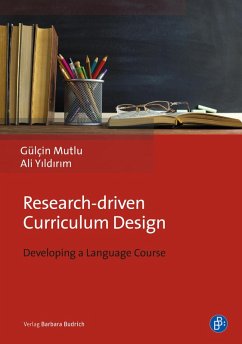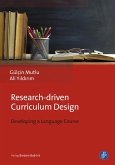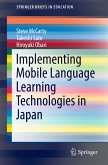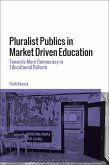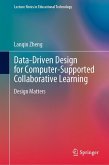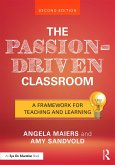Gülçin Mutlu, Ali Yildirim
Research-driven Curriculum Design (eBook, PDF)
Developing a Language Course
19,99 €
Statt 24,90 €**
19,99 €
inkl. MwSt.
**Preis der gedruckten Ausgabe (Gebundenes Buch)
Sofort per Download lieferbar

0 °P sammeln
19,99 €
Statt 24,90 €**
19,99 €
inkl. MwSt.
**Preis der gedruckten Ausgabe (Gebundenes Buch)
Sofort per Download lieferbar
Alle Infos zum eBook verschenken

0 °P sammeln
Als Download kaufen

Statt 24,90 €****
19,99 €
inkl. MwSt.
**Preis der gedruckten Ausgabe (Gebundenes Buch)
Sofort per Download lieferbar

0 °P sammeln
Jetzt verschenken
Alle Infos zum eBook verschenken
Statt 24,90 €****
19,99 €
inkl. MwSt.
**Preis der gedruckten Ausgabe (Gebundenes Buch)
Sofort per Download lieferbar
Alle Infos zum eBook verschenken

0 °P sammeln
Gülçin Mutlu, Ali Yildirim
Research-driven Curriculum Design (eBook, PDF)
Developing a Language Course
- Format: PDF
- Merkliste
- Auf die Merkliste
- Bewerten Bewerten
- Teilen
- Produkt teilen
- Produkterinnerung
- Produkterinnerung

Bitte loggen Sie sich zunächst in Ihr Kundenkonto ein oder registrieren Sie sich bei
bücher.de, um das eBook-Abo tolino select nutzen zu können.
Hier können Sie sich einloggen
Hier können Sie sich einloggen
Sie sind bereits eingeloggt. Klicken Sie auf 2. tolino select Abo, um fortzufahren.

Bitte loggen Sie sich zunächst in Ihr Kundenkonto ein oder registrieren Sie sich bei bücher.de, um das eBook-Abo tolino select nutzen zu können.
Die Untersuchung der Kursgestaltung ist eine wichtige empirische Art der Forschung. Allerdings vernachlässigen Kursdesigner*innen oft die akademischen Richtlinien in der Lehrplantheorie und -entwicklung. Diese Studie über Lehrplangestaltung und Kursdesign für Englisch als Fremdsprache (English as a Foreign Language, EFL) verbindet die Theorie mit der Praxis und bietet einen praktischen Leitfaden für Lehrer*innen bei der Planung von Fremdsprachenkursen.
- Geräte: PC
- ohne Kopierschutz
- eBook Hilfe
- Größe: 10.82MB
Andere Kunden interessierten sich auch für
![Research-driven Curriculum Design (eBook, ePUB) Research-driven Curriculum Design (eBook, ePUB)]() Gülçin MutluResearch-driven Curriculum Design (eBook, ePUB)19,99 €
Gülçin MutluResearch-driven Curriculum Design (eBook, ePUB)19,99 €![Implementing Mobile Language Learning Technologies in Japan (eBook, PDF) Implementing Mobile Language Learning Technologies in Japan (eBook, PDF)]() Steve McCartyImplementing Mobile Language Learning Technologies in Japan (eBook, PDF)48,95 €
Steve McCartyImplementing Mobile Language Learning Technologies in Japan (eBook, PDF)48,95 €![Pluralist Publics in Market Driven Education (eBook, PDF) Pluralist Publics in Market Driven Education (eBook, PDF)]() Ruth BoyaskPluralist Publics in Market Driven Education (eBook, PDF)25,95 €
Ruth BoyaskPluralist Publics in Market Driven Education (eBook, PDF)25,95 €![Justice in Search of Leaders (eBook, PDF) Justice in Search of Leaders (eBook, PDF)]() Gloria Graves HolmesJustice in Search of Leaders (eBook, PDF)78,95 €
Gloria Graves HolmesJustice in Search of Leaders (eBook, PDF)78,95 €![Post-Pandemic Pedagogy (eBook, PDF) Post-Pandemic Pedagogy (eBook, PDF)]() Post-Pandemic Pedagogy (eBook, PDF)25,95 €
Post-Pandemic Pedagogy (eBook, PDF)25,95 €![Data-Driven Design for Computer-Supported Collaborative Learning (eBook, PDF) Data-Driven Design for Computer-Supported Collaborative Learning (eBook, PDF)]() Lanqin ZhengData-Driven Design for Computer-Supported Collaborative Learning (eBook, PDF)128,95 €
Lanqin ZhengData-Driven Design for Computer-Supported Collaborative Learning (eBook, PDF)128,95 €![The Passion-Driven Classroom (eBook, PDF) The Passion-Driven Classroom (eBook, PDF)]() Angela MaiersThe Passion-Driven Classroom (eBook, PDF)29,95 €
Angela MaiersThe Passion-Driven Classroom (eBook, PDF)29,95 €-
-
-
Die Untersuchung der Kursgestaltung ist eine wichtige empirische Art der Forschung. Allerdings vernachlässigen Kursdesigner*innen oft die akademischen Richtlinien in der Lehrplantheorie und -entwicklung. Diese Studie über Lehrplangestaltung und Kursdesign für Englisch als Fremdsprache (English as a Foreign Language, EFL) verbindet die Theorie mit der Praxis und bietet einen praktischen Leitfaden für Lehrer*innen bei der Planung von Fremdsprachenkursen.
Dieser Download kann aus rechtlichen Gründen nur mit Rechnungsadresse in A, B, BG, CY, CZ, D, DK, EW, E, FIN, F, GR, HR, H, IRL, I, LT, L, LR, M, NL, PL, P, R, S, SLO, SK ausgeliefert werden.
Produktdetails
- Produktdetails
- Verlag: Verlag Barbara Budrich
- Erscheinungstermin: 10. Mai 2021
- Englisch
- ISBN-13: 9783847415633
- Artikelnr.: 61816312
- Verlag: Verlag Barbara Budrich
- Erscheinungstermin: 10. Mai 2021
- Englisch
- ISBN-13: 9783847415633
- Artikelnr.: 61816312
- Herstellerkennzeichnung Die Herstellerinformationen sind derzeit nicht verfügbar.
Gülçin Mutlu, Ph.D., works at Izmir Democracy University in Turkey. Ali Yildirim, Ed.D., works at the University of Gothenburg in Sweden.
Chapter 1: Introduction
Chapter 2: Review of Literature
2.1. Conceptual Background: Theoretical Influence on the Basis of Language Curriculum
2.1.1. Acquisition-learning distinction
2.1.2. Comprehensible input
2.1.3. Affective filter
2.1.4. Competence and performance in language
2.1.5. Nature of linguistic communication
2.2. Design and Procedural Background: Communicative Curriculum in Theory and Practice
2.2.1. Nature of language
2.2.2. Nature of language learning
2.2.3. Nature of educational-cultural philosophy
2.3. Research-wise Background: Studies in relation to English Speaking Skills
2.4. Authentic Materials and Communicative Competence
Chapter 3: Needs Assessment
3.1. A Snapshot of the Needs Assessment
3.1.1. Who Were Involved in the Needs Assessment?
3.1.2. What Types of Information Was Gathered? (Present Situation Analysis and Target Situation Analyses)
3.1.3. How Was This Information Gathered?
3.2. Needs Assessment Plan for the Further Speaking Course
3.2.1. Data collection procedures
3.2.1.1. A writing activity
3.2.1.2. Student Interviews
3.2.1.3. Teacher interviews
3.2.1.4. Questionnaires to the students
3.2.1.5. Meeting
3.2.2. Data analysis procedures
3.2.3. Results of the needs assessment
3.2.3.1. Results of the writing activity
3.2.3.2. Results of the teacher interviews
3.2.3.2.1. Results of the interviews with content department teachers
3.2.3.2.2. Results of the interviews with the English language teachers
3.2.3.2.3. Results of the interviews with students
3.2.3.3. Results of the student questionnaire
3.2.3.3.1. Results for the perceived difficulty on the skills
3.2.3.3.2. Results for the perceived importance on the skills
3.2.3.3.3. Results for the topic selection
3.3. Reflections from the Needs Assessment to Use in the Design of the Further Speaking Skills Curriculum
Chapter 4: Curriculum Design
4.1 Description and Components of the Curriculum Design Model Used
4.2. Application of the Model to the Further Speaking Course
4.2.1. Articulating beliefs.504.2.2. Defining the context and needs assessment
4.2.3 Formulating goals and rationale
4.2.3.1. Goals
4.2.3.2. Course rationale
4.2.4. Conceptualizing content and course grid
4.2.5. Organizing the course and course syllabus
4.2.6. Refined course goals and intended learning outcomes
4.2.6.1. Goals and intended learning outcomes for FSC
4.2.7. Instructional planning and an instructional plan for the FSC
4.2.8. Methods (teaching) strategies
4.2.8.1. Learner roles
4.2.8.2. Teacher roles
4.2.8.3. The roles of instructional materials
4.2.8.4. Instructional activities to be used
4.2.9. Planning Evaluation and an Evaluation Plan for the FSC
4.2.9.1. Course evaluation
4.2.9.2. Student evaluation
4.2.9.2.1 FSC Class evaluation plan
Chapter 5: Unit and Lesson Plan
5.1. Unit Plan
5.1.1. Rationale
5.1.2. Introduction
5.1.3. Sequence
5.1.4. Instructional foci
5.1.5. ILOs
5.1.6. General teaching strategies
5.1.7. Unintended learning outcomes
5.1.8. Evaluation
5.2. Lesson Plan
Chapter 6: Field Testing of the Unit Plan
Chapter 7: Discussion
7.1. Comments on the Process and Design
7.2. Suggestions for Further Course Design Work
Chapter 2: Review of Literature
2.1. Conceptual Background: Theoretical Influence on the Basis of Language Curriculum
2.1.1. Acquisition-learning distinction
2.1.2. Comprehensible input
2.1.3. Affective filter
2.1.4. Competence and performance in language
2.1.5. Nature of linguistic communication
2.2. Design and Procedural Background: Communicative Curriculum in Theory and Practice
2.2.1. Nature of language
2.2.2. Nature of language learning
2.2.3. Nature of educational-cultural philosophy
2.3. Research-wise Background: Studies in relation to English Speaking Skills
2.4. Authentic Materials and Communicative Competence
Chapter 3: Needs Assessment
3.1. A Snapshot of the Needs Assessment
3.1.1. Who Were Involved in the Needs Assessment?
3.1.2. What Types of Information Was Gathered? (Present Situation Analysis and Target Situation Analyses)
3.1.3. How Was This Information Gathered?
3.2. Needs Assessment Plan for the Further Speaking Course
3.2.1. Data collection procedures
3.2.1.1. A writing activity
3.2.1.2. Student Interviews
3.2.1.3. Teacher interviews
3.2.1.4. Questionnaires to the students
3.2.1.5. Meeting
3.2.2. Data analysis procedures
3.2.3. Results of the needs assessment
3.2.3.1. Results of the writing activity
3.2.3.2. Results of the teacher interviews
3.2.3.2.1. Results of the interviews with content department teachers
3.2.3.2.2. Results of the interviews with the English language teachers
3.2.3.2.3. Results of the interviews with students
3.2.3.3. Results of the student questionnaire
3.2.3.3.1. Results for the perceived difficulty on the skills
3.2.3.3.2. Results for the perceived importance on the skills
3.2.3.3.3. Results for the topic selection
3.3. Reflections from the Needs Assessment to Use in the Design of the Further Speaking Skills Curriculum
Chapter 4: Curriculum Design
4.1 Description and Components of the Curriculum Design Model Used
4.2. Application of the Model to the Further Speaking Course
4.2.1. Articulating beliefs.504.2.2. Defining the context and needs assessment
4.2.3 Formulating goals and rationale
4.2.3.1. Goals
4.2.3.2. Course rationale
4.2.4. Conceptualizing content and course grid
4.2.5. Organizing the course and course syllabus
4.2.6. Refined course goals and intended learning outcomes
4.2.6.1. Goals and intended learning outcomes for FSC
4.2.7. Instructional planning and an instructional plan for the FSC
4.2.8. Methods (teaching) strategies
4.2.8.1. Learner roles
4.2.8.2. Teacher roles
4.2.8.3. The roles of instructional materials
4.2.8.4. Instructional activities to be used
4.2.9. Planning Evaluation and an Evaluation Plan for the FSC
4.2.9.1. Course evaluation
4.2.9.2. Student evaluation
4.2.9.2.1 FSC Class evaluation plan
Chapter 5: Unit and Lesson Plan
5.1. Unit Plan
5.1.1. Rationale
5.1.2. Introduction
5.1.3. Sequence
5.1.4. Instructional foci
5.1.5. ILOs
5.1.6. General teaching strategies
5.1.7. Unintended learning outcomes
5.1.8. Evaluation
5.2. Lesson Plan
Chapter 6: Field Testing of the Unit Plan
Chapter 7: Discussion
7.1. Comments on the Process and Design
7.2. Suggestions for Further Course Design Work
Chapter 1: Introduction
Chapter 2: Review of Literature
2.1. Conceptual Background: Theoretical Influence on the Basis of Language Curriculum
2.1.1. Acquisition-learning distinction
2.1.2. Comprehensible input
2.1.3. Affective filter
2.1.4. Competence and performance in language
2.1.5. Nature of linguistic communication
2.2. Design and Procedural Background: Communicative Curriculum in Theory and Practice
2.2.1. Nature of language
2.2.2. Nature of language learning
2.2.3. Nature of educational-cultural philosophy
2.3. Research-wise Background: Studies in relation to English Speaking Skills
2.4. Authentic Materials and Communicative Competence
Chapter 3: Needs Assessment
3.1. A Snapshot of the Needs Assessment
3.1.1. Who Were Involved in the Needs Assessment?
3.1.2. What Types of Information Was Gathered? (Present Situation Analysis and Target Situation Analyses)
3.1.3. How Was This Information Gathered?
3.2. Needs Assessment Plan for the Further Speaking Course
3.2.1. Data collection procedures
3.2.1.1. A writing activity
3.2.1.2. Student Interviews
3.2.1.3. Teacher interviews
3.2.1.4. Questionnaires to the students
3.2.1.5. Meeting
3.2.2. Data analysis procedures
3.2.3. Results of the needs assessment
3.2.3.1. Results of the writing activity
3.2.3.2. Results of the teacher interviews
3.2.3.2.1. Results of the interviews with content department teachers
3.2.3.2.2. Results of the interviews with the English language teachers
3.2.3.2.3. Results of the interviews with students
3.2.3.3. Results of the student questionnaire
3.2.3.3.1. Results for the perceived difficulty on the skills
3.2.3.3.2. Results for the perceived importance on the skills
3.2.3.3.3. Results for the topic selection
3.3. Reflections from the Needs Assessment to Use in the Design of the Further Speaking Skills Curriculum
Chapter 4: Curriculum Design
4.1 Description and Components of the Curriculum Design Model Used
4.2. Application of the Model to the Further Speaking Course
4.2.1. Articulating beliefs.504.2.2. Defining the context and needs assessment
4.2.3 Formulating goals and rationale
4.2.3.1. Goals
4.2.3.2. Course rationale
4.2.4. Conceptualizing content and course grid
4.2.5. Organizing the course and course syllabus
4.2.6. Refined course goals and intended learning outcomes
4.2.6.1. Goals and intended learning outcomes for FSC
4.2.7. Instructional planning and an instructional plan for the FSC
4.2.8. Methods (teaching) strategies
4.2.8.1. Learner roles
4.2.8.2. Teacher roles
4.2.8.3. The roles of instructional materials
4.2.8.4. Instructional activities to be used
4.2.9. Planning Evaluation and an Evaluation Plan for the FSC
4.2.9.1. Course evaluation
4.2.9.2. Student evaluation
4.2.9.2.1 FSC Class evaluation plan
Chapter 5: Unit and Lesson Plan
5.1. Unit Plan
5.1.1. Rationale
5.1.2. Introduction
5.1.3. Sequence
5.1.4. Instructional foci
5.1.5. ILOs
5.1.6. General teaching strategies
5.1.7. Unintended learning outcomes
5.1.8. Evaluation
5.2. Lesson Plan
Chapter 6: Field Testing of the Unit Plan
Chapter 7: Discussion
7.1. Comments on the Process and Design
7.2. Suggestions for Further Course Design Work
Chapter 2: Review of Literature
2.1. Conceptual Background: Theoretical Influence on the Basis of Language Curriculum
2.1.1. Acquisition-learning distinction
2.1.2. Comprehensible input
2.1.3. Affective filter
2.1.4. Competence and performance in language
2.1.5. Nature of linguistic communication
2.2. Design and Procedural Background: Communicative Curriculum in Theory and Practice
2.2.1. Nature of language
2.2.2. Nature of language learning
2.2.3. Nature of educational-cultural philosophy
2.3. Research-wise Background: Studies in relation to English Speaking Skills
2.4. Authentic Materials and Communicative Competence
Chapter 3: Needs Assessment
3.1. A Snapshot of the Needs Assessment
3.1.1. Who Were Involved in the Needs Assessment?
3.1.2. What Types of Information Was Gathered? (Present Situation Analysis and Target Situation Analyses)
3.1.3. How Was This Information Gathered?
3.2. Needs Assessment Plan for the Further Speaking Course
3.2.1. Data collection procedures
3.2.1.1. A writing activity
3.2.1.2. Student Interviews
3.2.1.3. Teacher interviews
3.2.1.4. Questionnaires to the students
3.2.1.5. Meeting
3.2.2. Data analysis procedures
3.2.3. Results of the needs assessment
3.2.3.1. Results of the writing activity
3.2.3.2. Results of the teacher interviews
3.2.3.2.1. Results of the interviews with content department teachers
3.2.3.2.2. Results of the interviews with the English language teachers
3.2.3.2.3. Results of the interviews with students
3.2.3.3. Results of the student questionnaire
3.2.3.3.1. Results for the perceived difficulty on the skills
3.2.3.3.2. Results for the perceived importance on the skills
3.2.3.3.3. Results for the topic selection
3.3. Reflections from the Needs Assessment to Use in the Design of the Further Speaking Skills Curriculum
Chapter 4: Curriculum Design
4.1 Description and Components of the Curriculum Design Model Used
4.2. Application of the Model to the Further Speaking Course
4.2.1. Articulating beliefs.504.2.2. Defining the context and needs assessment
4.2.3 Formulating goals and rationale
4.2.3.1. Goals
4.2.3.2. Course rationale
4.2.4. Conceptualizing content and course grid
4.2.5. Organizing the course and course syllabus
4.2.6. Refined course goals and intended learning outcomes
4.2.6.1. Goals and intended learning outcomes for FSC
4.2.7. Instructional planning and an instructional plan for the FSC
4.2.8. Methods (teaching) strategies
4.2.8.1. Learner roles
4.2.8.2. Teacher roles
4.2.8.3. The roles of instructional materials
4.2.8.4. Instructional activities to be used
4.2.9. Planning Evaluation and an Evaluation Plan for the FSC
4.2.9.1. Course evaluation
4.2.9.2. Student evaluation
4.2.9.2.1 FSC Class evaluation plan
Chapter 5: Unit and Lesson Plan
5.1. Unit Plan
5.1.1. Rationale
5.1.2. Introduction
5.1.3. Sequence
5.1.4. Instructional foci
5.1.5. ILOs
5.1.6. General teaching strategies
5.1.7. Unintended learning outcomes
5.1.8. Evaluation
5.2. Lesson Plan
Chapter 6: Field Testing of the Unit Plan
Chapter 7: Discussion
7.1. Comments on the Process and Design
7.2. Suggestions for Further Course Design Work
